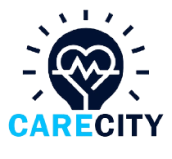Technology and Community Health. Part 1.
How Technology Can Improve the Health of Rural Communities.
By
Ayinla Daniel Rn, Rctn.
(Editor Care City).

In developing countries in Asia and Africa, small communities who are far away from urban life and the health services that are available in more developed parts can also enjoy the benefits health care technology has to offer. Smartphones have been able to help humanity achieve a whole lot in the area of information communication which is the bedrock of community, men have to communicate with themselves at all times, hence the internet is our own global village, a place where we can see our selves, read our ideas, partake in our goals and visions together and make the world a better place together, because of the science and technology of information communication.
Health care is among the most basic needs of humanity. As information and communication, health care is a vital aspect of man’s existence, he must be able to take care of his sick ones, those who need support in one way or the other, the vulnerable among his ranks. The coming together of health care and technology, especially information communication technology is like a miracle, because more lives are being saved on daily basis because of access to accurate health information and the constant health care innovations that go on every day – seeking to discover new methods of taking care of the sick, discovering cures to life-threatening disease conditions and even attempting to prolong life.
Remote communities in developing countries who do not have direct access to health care services can create strong links, tied by the ever trusted fibres of DATA. Data is number and number is life.
If more communities are integrated into health care services that utilise the technology of data management, the rate of health care interventions/services in the community levels will drastically increase.
Nurses and community health practitioners are at the best position to play this role of “Community Data Agents,” were they are able to gather important information about the overall health of a community and feed this data into systems that synthesize them; utilising them to create health care services peculiar to a particular community’s need.
Community health care practitioners must be conversant with the operation of these basic technologies. There are worldwide interventions by large bodies interested in community health that are making an impact in the communities using the tool of information communication technology.
The mother and child, who are the most vulnerable are the populations that will enjoy more the benefits of health care technology. Mobile phones are now used to provide mothers in rural areas with vital information about hygiene and newborn care. The elderly who are in rural communities can also enjoy care services compared to this, were health care workers pay occasional visits, health educate them on the technical know-how on how to use smartphones to send vital information about their health conditions which are accessed and interventions are planned afterwards.
Smart health applications can be designed – easy to navigate with user friendly interfaces that makes interaction with the software easy, these applications can be used to communicate with the primary health care centres or direct providers of specific health care services who now work in collaboration with primary health care centres to provide these health care needs to those who are in need in these areas.
Community health workers are the strong links between the poorest of the poor and the providers of health care services. In countries like Nigeria, people living in rural communities, especially mothers and children are not sufficiently exposed to good health care information, this may be due to a number of factors, but we are not considering these factors today, what we are considering are the numerous opportunities that lie fallow in these kinds of environments.
Primary health care centres, if not equipped with the state of the art equipment in diagnostics or interventional medicine, should be able to boast of basic tools that make communicating health care information easy, while catering for the health care Information needs of the community, these should have the necessary requirements to collect data from the community, collate and send to appropriate quarters that now synthesise data, make appropriate interventions and either send support or required needs.
The Primary Health Care centres are the roots of health care practice because they provide health care services to a larger percentage of the population – the poor folks. The rich can afford health care assessments at all times, but those who are far away from the stream can also enjoy these services when information technology is integrated into health care.
In the next article, I will bring together some very encouraging news about what concerned bodies all over the world are doing as regards providing communities with health care through technology, I will also include my perspectives/ideas, what I feel can be done in these situations of lack of health information in remote communities.
Do stay tuned!




